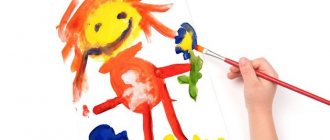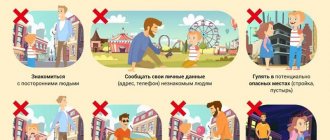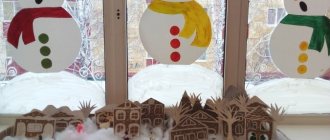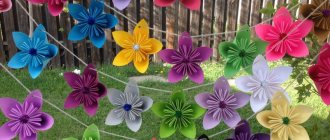A preschool educational institution is an organization where primary public education of children is carried out, the first link of public education in most developed countries. Toddlers and older preschoolers are in kindergarten from about seven in the morning until five or seven in the evening, learning the minimum necessary communication skills, playing, and preparing for school. To prevent separation from parents for the whole day from being too traumatic for the baby, conditions similar to those at home are created in the preschool educational institution - an abundance of toys, friendly teachers, and the opportunity to sleep during the day. An important factor is the design of the kindergarten - beautiful, comfortable premises, safe areas.
Design principles
When choosing a kindergarten, the first thing parents pay attention to is the interior. This is the calling card of the institution; it is designed harmoniously, in a memorable manner. Children should feel comfortable in it so that they want to return there every day.
The basic principles of the improvement project are approximately the following:
- compliance with the name - the “Bee” kindergarten should have in its design figurines of bees, black and yellow elements, and the “Fairy Tale” kindergarten should have images of heroes of famous fairy tales;
- the walls of corridors and lobbies are painted with various scenes so that children find it interesting to look at them;
- clear zoning - each group must have a separate locker room, bedroom, games room, in harmony with each other;
- the interior for children of different ages is decorated with different pictures - for the younger group, the plots of “Ryaba Hen”, the cartoon “Little Kids” are suitable, for older ones - fairy tales about “The Sleeping Beauty”, “Ivan the Tsarevich”, etc.;
- The design materials chosen are environmentally friendly, predominantly natural.
European style
In private kindergartens in Europe, a functional interior is becoming increasingly popular: an abundance of different cabinets for toys, floor shelves for books, simple forms of furniture are complemented by cozy textiles and simple drawings on the walls. The basis of this direction is the creation of a cozy and comfortable space using natural and environmentally friendly materials. Therefore, wood is often used in the interior, complementing it with elements of pastel shades.
Wall decoration
Discreet Europeans often create a fairly calm interior in pastel or natural light shades. Only one wall can be decorated, and the rest are made plain or with minimal decoration.
European style walls
European style walls
Furniture
Simple and comfortable furniture will be the best addition to such an environment: multifunctional cabinets, tables and chairs of classic shapes made of light wood or chipboard will create a simple and comfortable interior, emphasizing its environmental friendliness and naturalness.
European style furniture
European style furniture
Lighting
Lamps of simple shapes made of glass, metal or even rice paper will fit perfectly into the restraint of European design, and will also create the necessary degree of illumination. The difference between zones and the orientation of rooms can be emphasized with the help of light elements of different shapes and textures.
European style lighting
European style lighting
Entry group
An elegant painting or decoration in the spirit of a magic castle is perfect for decorating the facade of a private kindergarten: a bright, noticeable sign and a spectacular picturesque facade are guaranteed to attract the attention of children and their parents. If the room is small, then you can limit yourself to painting on the walls, but if the garden occupies the entire building, then turrets imitating a castle and a beautiful garden will create a feeling of being transported into a fairy tale.
Entrance group in European style
Entrance group in European style
Materials, finishing methods
Basic, most commonly used materials:
- tree;
- Fiberboard;
- MDF;
- plastic;
- drywall;
- ceramic tile;
- dye;
- wallpaper.
All materials must be harmless to children’s health and have radiation safety certificates. Ceilings are most often whitewashed and painted with water-based paint. The walls are made smooth so that they are easy to clean, and the floors are not slippery. The walls, floors of sanitary premises, catering units are decorated with tiles, oil paint, and decorative plaster. The floors in the groups are made of wood, laminated, natural linoleum, without cracks or protruding parts. In cold regions, heated floors are preferred. In groups, rugs and rugs are laid on the floor.
The furniture is also selected to be environmentally friendly, comfortable, and light. Preferably one that “grows with the child” - adjustable in height. It can be hard or soft.
Hygiene zone
Usually the hygiene area, especially for the youngest children and their teachers, is a “stumbling block”. It’s difficult to teach a baby to carry out all hygiene procedures at home, and even more so in kindergarten. Therefore, this area should be designed as interesting as possible. Not only should all the accessories of such an area - washbasins, pots, urinals and toilets - be very convenient for children of a certain age group, but also special sanitary standards must be observed.
It is best to decorate this area with tiles with a pattern of the appropriate theme - this is both a guarantee of cleanliness and interesting for children. All accessories must be strictly according to the height of the children and preferably dark in color - for example, dark blue or dark blue.
For small children, special footrests must be provided so that they can comfortably use washbasins. Moreover, the stands should be wooden, upholstered in fabric or leather of the appropriate color. All towel holders should be located at the same height as the height of the children of this age group. The best option would be to make a smooth transition in height from one side to the other - then small children and tall children will always clearly know their washing places and there will be no confusion.
Plastic containers for used paper must be attached to the floor and it is best if they continue the theme of the kindergarten.
Color palette
Rooms with windows facing north are painted in warm colors - beige, light yellow, orange-pink, peach. “Southern” rooms are decorated in cold colors – light blue, pale green, soft violet. Up to 25% of the area can be painted more brightly, but use a minimal amount of aggressive colors.
With the help of color, rooms are zoned - individual places are highlighted with bright colors and pictures.
How do different colors affect children?
- pink – calms, the child feels safe;
- blue – promotes concentration and relaxation;
- blue – gives calmness, relieves internal tension;
- yellow – helps to communicate, learn new skills;
- red – gives self-confidence, in large quantities increases anxiety;
- green – improves brain function, too bright can tire you.
Food area
As mentioned above, the problem of feeding children at this age is sometimes quite acute. That is why the food area should be designed in such a way as to arouse children's appetite. The colors of the design should be bright enough (this stimulates the secretion of gastric juice, and therefore the child’s appetite), but not harsh on the eyes. Orange comets against a dark blue sky, golden stars on the ceiling, bright red flooring - all this will whet the appetite of kids.
The most interesting option may be a porthole window into the catering area, through which food will be served to the children. This will be an exciting game for them. And if you decorate the cornice of the suspended ceiling with light bulbs of different colors and turn on different lighting after each change of dishes (the first course, then the main course and drinks), you will never have problems with food. The plates on the tables will remain clean and no one will hear your whims.
Design of individual rooms or zoning
Zoning of space occurs by dividing it into functional zones with defining boundaries.
What are the boundaries?
- volumetric - partitions, screens, walls, furniture, curtains;
- spatial – these are different floor heights in different zones, colors, lighting, architectural elements;
- combined - the space is simultaneously divided and connected, these are stained glass windows, grilles, curtains, columns, arches;
- translucent, completely transparent - this is how physical separation is achieved while maintaining a visual connection.
Flexible zoning is preferred - prefabricated cabinet structures, sliding partitions, screens, transparent screens. Children often take a direct part in zoning, together with their teachers. Platform podiums with fences and various partitions are often used - straight, angular, curly, of various heights, widths, lengths. The decorative design of the ceiling on holidays will also become an element of division into zones - these are flags, balloons, paper garlands.
Senior groups are often located on the second floor, so the safety and aesthetic appearance of the stairs should also be taken care of. The walls along them should be beautifully decorated - for example, there should be an exhibition of graphic and painting works by students.
Play and study room
Most often, children play and eat in the same rooms. Furniture is selected according to the height of the children - in the younger and older groups it will vary greatly in height.
Posted here:
- tables, chairs;
- racks for books, toys;
- paints, felt-tip pens;
- finished works made by children's hands;
- musical instruments.
The walls are decorated with bright, non-aggressive wallpaper and drawings - developing stories, episodes from fairy tales and cartoons are welcome. In the play area, a soft, warm carpet is laid on the floor. Cabinets, racks for toys, books are selected with minimal risk of injury, are stable, and are well secured. The study area should be sufficiently well lit, visually separated from the play area by a different floor covering, walls, or with the help of partitions. Here children learn to read, write, draw, and sculpt. Zones of various games are separated from each other by decorative houses and screens - a kitchen with a toy set, a railway, a Lego town.
Dining area
The dining room is separated from the playing area by a screen and shelving. For ease of cleaning, do not place a carpet in this place, because children often drop food on the floor, spill it, and scatter it. The furniture here includes tables designed for two to four people, and chairs suitable for the height of the bench. On the wall there is a menu, an explanatory note, which describes and depicts how to properly use a spoon, fork, and napkins. The tables are covered with tablecloths and colorful oilcloths. Cartoon characters are often depicted on the walls eating.
Locker room
This is one of the first rooms where children and their parents find themselves when they come from the street. It is decorated brightly, a variety of subjects are used, wallpaper with images of animals and fairy-tale characters is used. Stands with important information, announcements, schedules, and height meters are placed on the walls. They draw on clothes lockers, stick different letters and pictures on them so that each child can easily remember his own and find where his things are. Long benches are placed in the center of the locker room so that the students can dress comfortably, and a carpet is laid on the floor.
Bedroom
The bedroom is intended for daytime sleep, night rest in the gardens with 24-hour stay. It is decorated in calm, mostly pastel, tones. Thick curtains are hung on the windows - the room should be darkened during the daytime rest. They are selected from natural, eco-friendly materials that suit the style. The structures to which they are attached must be highly reliable, and the fabrics must be practical and durable. You can simply whitewash the ceiling or depict a starry sky on it.
What should a bathroom be like?
Strict requirements are imposed on kindergarten bathrooms. Ceramic tiles are laid on the floor, which are easy to clean; on the walls, such covering should be at least one and a half meters high. In the younger groups, the toilet is equipped with pots, in the middle and older groups - with toilets, washbasins, and mirrors. The older the children, the more spacious this room should be. For older children, toilets are located in stalls, but the doors should not have locks. Each student has his own towel, which he hangs on a hook in a separate compartment. In the showers, drainage is provided through holes in the floor; for safety, rubber mats and wooden pallets are used.
Consultation for educators: Children's design in kindergarten
Olga Kondratieva
Consultation for educators: Children's design in kindergarten
“Creativity is not the preserve of only geniuses who have created great works of art. Creativity exists wherever a person imagines, combines, creates something new."
L. S. Vygotsky
The art of design is actively entering our lives.
And today I would like to study the concept of “Children's design”.
Children's design is a new artistic and productive activity, which is understood as design thinking of the widest range.
In design, not only the development of the concept is important, but also the planning of the result, which contributes to the development of the child.
Children's design is aimed at revealing the child's personality, his individuality, the development of his creative potential, free, without pressure from an adult, based on the child's self-expression, his self-development, cooperation and co-creativity, using only humane methods and techniques, without prohibitions and categorical appeals .
When we talk about a child designer, we often mean a child artist. In fact, design is an unusual look at ordinary things. This means that the main thing for a designer is non-standard thinking, fantasy, imagination, and the ability to combine color and shape. It follows from this that in order for a child to become a designer, first of all it is necessary to develop his spatial imagination and encourage a non-standard vision of the world around him.
We often do not support the child’s imagination, and if he draws a pink elephant, we correct him and say: this does not happen, the elephant must be gray. At first the child objects: “He’s fabulous, magical.” But if an adult constantly gives the “correct” example, the baby fantasizes less and less.
Design activity is a special type of artistic activity that combines various types of creativity: drawing, modeling, appliqué, design, artistic work.
In kindergarten practice, the contents of the concepts are often mixed: “visual activity” (with handicrafts, “creative design” and the actual activity of “children’s design”. Naturally, these restrictions are conditional, but at the same time the following should be noted: children’s products after artistic and didactic activities, folded into folders and boxes and no longer in demand - this is not yet children's design. Children's design is associated with the decorative activities of the child himself to improve the subject-spatial environment around him.
At the same time, professional design has common features with children's design, that is, visual activities and construction. This:
— originality and uniqueness of the creative product;
-introduction to the system of sensory standards, a prerequisite for the modular design principle;
- jointly separate nature of the execution of the plan;
— substantive and spatial-decorative nature of design activities;
— use of similar materials and techniques;
-a general approach to assessing the artistry of professional and “children’s” art;
— self-sufficiency and non-competitiveness of children's creative products
The first steps into the art of design are so simple that they do not require much effort from the child. He discovers the world of matter with pleasure. Gradually, experience will come, skills will be formed, and he will easily complete a large, complex work on his own. In addition, today, more than ever before, there is a need for the formation of a harmoniously developed personality. A person who will study, protect and develop the spiritual heritage of our people. All this is of great importance: a person who sees and knows how to appreciate beauty will preserve and increase it; such people are not capable of immoral acts. That is why design classes are so relevant - the activities of older preschoolers. Children develop artistic and creative abilities, their creative potential is revealed through artistic and constructive design, as well as:
• visual-figurative thinking develops; artistic and aesthetic taste, sense of style;
• artistic perception of the surrounding world, imagination, fantasy, creative thinking develops;
• the aesthetic culture of children increases;
• cognitive activity, fine motor skills, spatial orientation, perception develops;
• gaining skills in working with various materials;
• formation of a project culture in children and education of a literate consumer.
Design classes are designed to influence the mind, will, and feelings of children, to encourage them to creative self-expression, a state of emotional comfort, and a sense of the joy of childhood in various types of artistic and creative activities using non-traditional techniques: collage, test plastic, origami, quilling, papier-mâché , scrapbooking, grattage, decoupage, isothread, etc.
Involving children in design is a noble, but difficult and time-consuming endeavor.
Now let's talk about techniques.
Modeling is the process of creating a sculptural work associated with working on a soft plastic material.
You can sculpt from clay and plasticine, but it’s interesting to learn something new. Salt dough is the most economical and safe way to try your hand at developing your imagination, because you can mold anything from it. Dough is a material accessible to everyone, cheap and easy to use; it can be prepared in advance (for future use). The dough can be colored and sculpted into a colored product, or you can paint the finished work after it has completely dried. The beauty and elegance of “salty crafts” will provide food for creative thought. The work is easy and durable.
Papier-mâché is not only a beautiful French name, but also a very simple, low-cost technique for making various crafts from pieces of paper. Doing such creativity in kindergarten is a pleasure.
There are three technologies for making papier-mâché products.
According to the first technology, the product is made by layer-by-layer gluing small pieces of wet paper onto a pre-prepared blank.
According to the second method, products are formed from liquid paper pulp. Paper cut into small pieces is poured with hot water and placed in a warm place for a day. Then it is boiled, squeezed, loosened and dried. The resulting paper pulp is thoroughly mixed with chalk. Add glue to the paper-chalk mixture with constant stirring until a plastic, creamy dough is obtained. A mixture of starch paste and wood glue is used as glue. The dough is poured into the prepared form or applied in a layer on its surface and left until completely dry.
According to the third method, products are glued together like plywood under pressure from plates of hard, dense cardboard. The resulting product is primed and painted.
Scrapbooking is a craft that involves designing, creating and decorating albums, packaging boxes, picture and photo frames, and gift cards.
Children always want something new and interesting. Exciting tasks can keep a child busy for more than an hour.
Origami for children is an application that, on the one hand, will be interesting for children, and on the other hand, complex. Origami for children not only allows you to distract the child from something, but also develops children's manual dexterity. Thanks to this, you can give your child the opportunity to decorate the house himself. Of course, he will take on this task quite responsibly. That is, we can see how origami develops in a child something beyond physical achievements - excellent moral qualities.
Quillin g is the art of paper rolling, which is hundreds of years old.
As practice has shown, paper processed using the quilling technique is very durable and strong. Therefore, all products made from it are widely used in everyday life. You can make a candy bowl and use it for its intended purpose. Even on a voluminous cup stand, you can place your favorite cup of coffee without any worries.
Working with isothread technique is a fascinating activity not only for adults, but also for children. At first glance, it seems that this technique is very complicated, but in fact you just need to learn the pattern and everything will work out great.
You need to master the technique of filling a corner, a circle, a web. After this, you will be able to complete quite complex paintings using the isothread technique.
Teach this art to your child, it is not only interesting, but also useful. This hobby develops a child’s perseverance, eye, imagination and abstract thinking, hand coordination and fine motor skills, and fosters accuracy and attention.
Teachers of preschool institutions are well familiar with the grattage technique , translated from French as “scratching.” This technique is popular because it has great artistic and expressive possibilities - a light shimmering underpainting appears against a dark background, which gives the work mystery and fabulousness. The scratching technique allows children to easily complete coloristic and graphic tasks, and educators to create unusual play situations during their work.
Decoupage is a very popular modern technique for decorating various items: from small plates and vases to spacious chests of drawers and cabinets. The decoupage technique is not very complicated, but it does have techniques that require certain skills and abilities.
The essence of the decoupage technique is that a thin layer of paper with a decorative pattern is glued onto the surface of the object being decorated, creating the illusion of hand-painting. Decorative patterns are produced on special napkins for decoupage. In addition, the decoupage pattern can be cut out from a regular paper napkin, from a magazine, postcard, label, or even from wrapping paper.
Collage is a relatively young direction in the visual arts. It is the brainchild of the last turbulent century, when artists were looking for new means to express their thoughts, feelings and moods. The collage technique (from the French collage - gluing) provides wide scope for creativity, since the whole is created from the fragmentary. Fragments can be photographs, glossy magazines, multi-colored paper, different textures, fabric, foil, plants, paints, fabrics, metal parts and much more.
Collage is a very interesting technique; it can combine most non-traditional techniques; in a collage you can use testoplasty, grattage, isothread, quilling, and much more, it all depends on how rich your imagination is.
Thank you very much for your attention!
Decoration of children's playgrounds
There are two main zones on the territory of the kindergarten:
- recreational - where students walk and play;
- economic - special transport arrives there and performs loading and unloading.
Experts recommend making playgrounds different - for children of different ages, their communication, games, and any events. The presence of natural areas is complemented by play elements made from natural materials. Also, convenient access to the territory of the preschool educational institution is provided, and the presence of short-term rest areas for adults who look after children is encouraged. Various techniques of modern landscape design are used.
On the site there are:
- sandboxes;
- swing;
- horizontal bars;
- stairs;
- sun canopies;
- tables, chairs, benches;
- equipped places for sports games;
- houses, gazebos;
- plot sculptural compositions.
Some of the decor is easy to make with your own hands - animals from car tires, ladders from wooden slices, logs, miniature buildings from plywood, flower beds, alpine slides. Trees are made from colored plastic bottles, flower bed fences are made, paths are lined with pebbles painted to look like ladybugs and beetles. All decorative elements are painted with bright colors, and the walls of the kindergarten building are decorated with fairy-tale scenes.
Often the garden building has a gym or a swimming pool - children need to develop physically. The gym is equipped with a wall bars, balls, trampolines, basketball hoops, hoops, and skittles. The swimming pool must comply with safety standards, be equipped with life buoys, and be of shallow depth.
Classic design
The classic interior design of a private kindergarten implies a bright space, created based on the taste preferences of preschool children: a bright interior, an abundance of light and comfortable furniture and, of course, favorite cartoon characters on the walls. You can complement such an interior with drawing boards or bookshelves of interesting shapes (for example, in the shape of a leaf, flower or tree).
Wall decoration
Interior walls for children in a classic style are usually painted in children’s favorite colors: blue, green, yellow, pink, etc. They should be bright or pastel shades; white, gray and beige colors are practically not used. As a covering, you can use artistic wall painting or bright wallpaper. An excellent addition would be a ceiling with clouds or an image of the sun - the flight of fancy in this case is practically unlimited. In such an environment, the child gets the feeling of being in a magical fairy-tale world, and fairy tales are never faded or black and white.
Classic style walls
Classic style walls
Furniture
Bright furniture in rich colors is the best addition to a classic design. Multi-colored shelves or drawers, tables and chairs in rich colors will be an excellent choice. You should take care of a sufficient number of places to store toys and art supplies by thinking through several cabinets in advance.
Classic style furniture
Classic style furniture
Lighting
To maximize illumination of the space, you should choose several types of lighting fixtures: spotlights will create the necessary abundance of light, and unusual lamps in the shape of stars or clouds will act as decorative elements.
Classic style lighting
Classic style lighting
Entry group
To decorate the façade and entrance area, you can use your favorite fairy tale and cartoon characters: Winnie the Pooh, Snow White and the Seven Dwarfs or Masha and the Bear will attract attention and create a sunny mood even on cloudy days.
Entrance group in classic style
Entrance group in classic style
When designing a stylish interior, it is important to remember its functionality and safety for children. Avoid sharp corners, protruding wires, open sockets, accessible electrical appliances and an abundance of textiles. The space should be well lit, preferably natural light. Compliance with these simple rules and a unified interior design, in which every detail will be thought out, will help create a festive atmosphere in a private kindergarten and get into a fairy-tale world.
Creating a living corner
A living corner is a developmental area that teaches children the first skills of caring for animals and plants, allowing them to observe their behavior and development.
People most often living here are:
- hamsters;
- rabbits;
- Guinea pigs;
- decorative mice, rats;
- parrots, canaries;
- turtles, lizards;
- certain types of aquarium fish.
Various indoor plants in pots are often placed here - it is important to choose exclusively non-poisonous ones that cannot cause allergies or injure curious children with thorns or thorns. Children give animals food, clean cages under the supervision of adults, water flowers from watering cans, learning about the world of flora and fauna. All necessary equipment is stored here - children learn to use it.
All about decor and choice of textiles
Textiles are selected to match the overall color scheme. All fabrics are preferred natural, environmentally friendly, fireproof. Dust should not accumulate on them; bedding fabrics must not contain components that can cause allergies. High-quality textiles will not have to be changed after one or two years; they will not fade in the sun or lose their appearance. Pupils, together with adults, make crafts from fabrics, paintings, appliqués from felt on a linen base, sewn toys to decorate the head’s office. Themes and plots used are different.
Rag wall organizers for stationery and interior dolls will also decorate the interior of the room. In the bedroom there are decorative panels depicting sleeping animals, in the dining area there are textile paintings where cartoon characters eat and prepare food. Several textile tents are placed in the games room, in which some children can hide and retire if necessary.
Fabric pockets for a children's locker are easy to make yourself. To do this, you will need about a meter of fabric, from which two pieces 30 by 80 cm are cut, two pockets 40 by 20 cm and 40 by 15 cm. An elastic band is sewn into the upper parts of the pockets, on which they are slightly pulled together, sewn to the base one after the other, starting from the bottom. Afterwards the second part of the base is attached, a strip of plastic is inserted at the top and bottom for rigidity. The edges are decorated with bias tape and strips of the same fabric. Loops are sewn into the upper part on which the pockets will hang. They store spare panties, socks, gloves, a hat, a comb, and office supplies. If desired, the design is decorated with embroidery, applique, and beads.
Bedroom
The bedroom is another very important area for a kindergarten. And again, it all depends on the psychology of the kids - many simply cannot stand going to bed during the day. The room should be decorated in soothing colors - the walls are muted blue, the ceiling is a little darker. You can make a ceiling in the form of a starry sky, but without lighting. It is best to place the lamps along the curb of the suspended ceiling cornice along its perimeter - this way the lighting will become muted and diffused.
Since babies sleep during the daytime, the curtains should be thick and dark to allow soft light to penetrate. Indigo or purple curtains are best - these colors are soothing. But too thick curtains cannot be used here! Firstly, thick curtains collect too much dust, and this is harmful for children. Washing thick curtains every week is simply unrealistic. And secondly, many kids are afraid of the dark, so every time they fall asleep they will be accompanied by fears.
If, after all, the curtains provide this darkness (especially in the autumn-winter period, when it is not very light outside), then the lighting strips located under the curb of the suspended ceiling cornice will come to the rescue.








